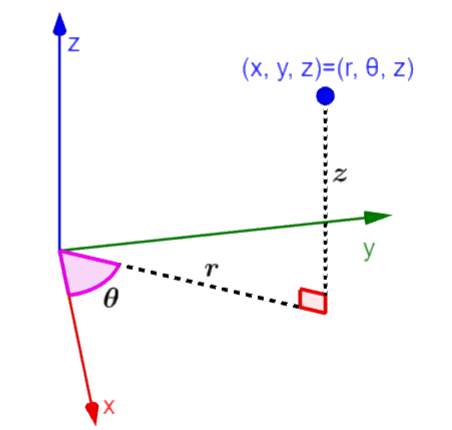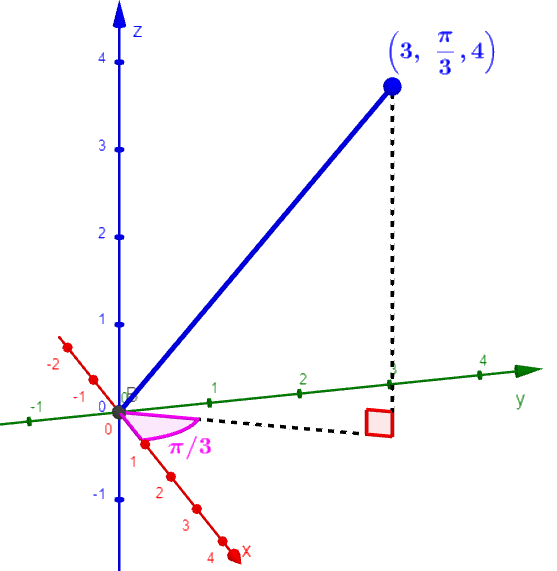Coordinate systems can be defined as ways of locating points in space. In three-dimensional space, the Cartesian coordinate system has the form (x, y, z). However, this system is not always the most convenient, so we have alternative coordinate systems. One of these systems is the cylindrical coordinate system. The cylindrical coordinates are considered as an extension of the polar coordinates towards the third dimension.
The general form of the cylindrical coordinates is (r, θ, z), where, r is the distance from the origin to the point in the xy plane, θ is the angle formed with respect to the x-axis, and z is the same z component as in Cartesian coordinates.
What are cylindrical coordinates?
Cylindrical coordinates are defined as an alternate three-dimensional coordinate system to the Cartesian system. Cylindrical coordinates are written in the form (r, θ, z), where, r represents the distance from the origin to the point in the xy plane, θ represents the angle formed with respect to the x-axis and z is the z component, which is the same as in Cartesian coordinates.

This coordinate system is used mainly to graph cylindrical-shaped figures such as tubes or tanks. This is mainly convenient in calculus since depending on the given equations, finding their derivatives or integrals can be easier.
Examples of cylindrical coordinates
To locate a point in cylindrical coordinates, we start by locating it in the xy plane by measuring the distance from the origin and measuring the angle from the x-axis. Then, we add the z component. In the following graph, we can look at the point $latex (3, \frac{\pi}{3}, 4)$.

A characteristic of cylindrical coordinates is that we can describe a point using several coordinates. That is, there is an infinite number of coordinates for each point. This is because the angle θ can be written in different ways.
If we add or subtract 2π, we get an equivalent angle. For example, the angles $latex \frac{\pi}{2}, \frac{5 \pi}{2}$, and $latex – \frac{3 \pi}{2}$ are the same.
Cylindrical to Cartesian conversion formulas
We use the following diagram to derive the conversion formulas from cylindrical coordinates to Cartesian coordinates:

We can see that the z coordinate is the same in both systems. Therefore, we just have to find the values of x and y in terms of r and θ. We can use the cosine function to find the x component and the sine function to find the y component. Therefore, we have:
| $latex x=r~\cos(\theta)$ $latex y=r~\sin(\theta)$ $latex z=z$ |
EXAMPLE 1
If we have the cylindrical coordinates $latex (3, \frac{\pi}{4}, 4)$, what is their equivalent in Cartesian coordinates?
Solution
We can recognize the values $latex r=3, ~\theta=\frac{\pi}{4}$. We use the formulas seen above with these values:
$latex x=3 \cos(\frac{\pi}{4})$
$latex x=2.1$
$latex y=3 \sin(\frac{\pi}{4})$
$latex y=2.1$
The Cartesian coordinates are (2.1, 2.1, 4).
EXAMPLE 2
We have the cylindrical coordinates $latex (10, \frac{7 \pi}{4}, 5)$. What is its equivalent in Cartesian coordinates?
Solution
We have the values $latex r=10, ~\theta=\frac{7\pi}{4}$. Using these values, we find the values of x and y:
$latex x=10 \cos(\frac{7\pi}{4})$
$latex x=7.07$
$latex y=10 \sin(\frac{7\pi}{4})$
$latex y=-7.07$
The Cartesian coordinates are (7.07, -7.07, 5).
Cylindrical to Polar conversion Formulas
To derive the conversion formulas from Cartesian to cylindrical coordinates, we are going to use the same diagram:

The value of r is found using the Pythagorean theorem with the x and y components. So, we have:
$latex {{r}^2}={{x}^2}+{{y}^2}$
| $latex r=\sqrt{{{x}^2}+{{y}^2}}$ |
The angle θ can be found using the inverse tangent. We know that the tangent is equal to the opposite side divided by the adjacent side. In the diagram, we see that the opposite side is y and the adjacent side is x. Therefore, we have:
| $latex \theta=\tan^{-1}(\frac{y}{x})$ |
Something to keep in mind with this angle is that sometimes the value given by the calculator is wrong. This is because the inverse tangent outputs with a range from $latex – \frac {\pi}{2}$ to $latex \frac{\pi}{2}$ and this does not cover all four quadrants.
We can correct this by adding 180° or π when the point is in the second and third quadrants and adding 360° or 2π when the point is in the fourth quadrant. When the point is in the first quadrant, the value given by the calculator is correct.
EXAMPLE 1
The point (4, 6, 7) is in Cartesian coordinates. What is its equivalent in cylindrical coordinates?
Solution
We have the values $latex x=4,~y=6$. We can find r and θ using the formulas given above. Therefore, the value of r is:
$latex r=\sqrt{{{x}^2}+{{y}^2}}$
$latex r=\sqrt{{{4}^2}+{{6}^2}}$
$latex r=\sqrt{16+36}$
$latex r=\sqrt{52}$
$latex r=7.2$
The angle θ is:
$latex \theta={{\tan}^{-1}}(\frac{y}{x})$
$latex \theta={{\tan}^{-1}}(\frac{6}{4})$
$latex \theta=0.98$ rad
Both the x component and the y component are positive, so the point is in the first quadrant and the angle obtained is correct.
The coordinates of the point are (7.2, 0.98 rad, 7).
EXAMPLE 2
We have the point (-3, -6, 5) in Cartesian coordinates. What is its equivalence in cylindrical coordinates?
Solution
We have $latex x=-3,~y=-6$. We use the formulas above to find r and θ:
$latex r=\sqrt{{{x}^2}+{{y}^2}}$
$latex r=\sqrt{{{(-3)}^2}+{{(-6)}^2}}$
$latex r=\sqrt{9+36}$
$latex r=\sqrt{47}$
$latex r=6.9$
The angle θ is:
$latex \theta={{\tan}^{-1}}(\frac{y}{x})$
$latex \theta={{\tan}^{-1}}(\frac{-6}{-3})$
$latex \theta=1.11$ rad
Both the x component and the y component are negative, so the point is in the third quadrant and we have to add π to get the correct angle. Therefore, the correct angle is $latex \theta = 1.11 + \pi = 4.25$ rad.
The coordinates of the point are (6.9, 4.25 rad, 5).
See also
Interested in learning more about cylindrical coordinates? Take a look at these pages:



